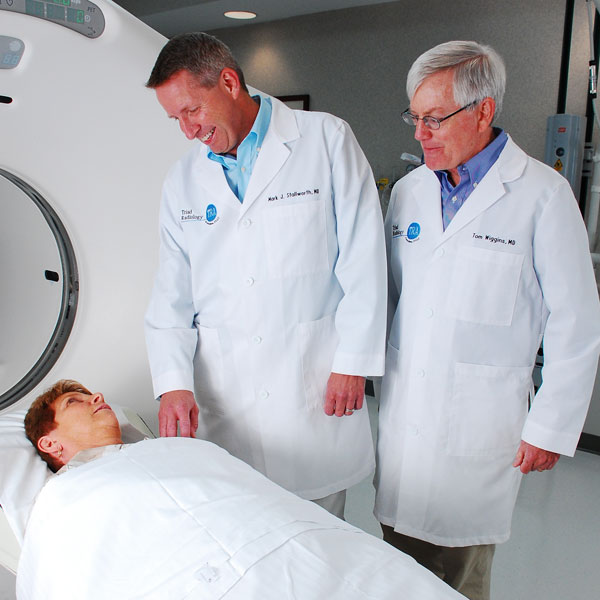Image Guided Drainages and Biopsies
Feeling apprehensive when you are having an image-guided biopsy or drainage is understandable — but the staff at Triad Radiology Associates will help you to relax and discuss any concerns that you have.
Thoracentesis and Paracentesis
Thoracentesis and Paracentesis are minimally-invasive procedures used for removing fluid buildup in the body.
Thoracentesis is used to diagnose and treat pleural effusions, a condition in which there is excess fluid in the pleural cavity. The pleural cavity is the space between the outside of the lungs and the inside of the chest wall. Thoracentesis is often used to relieve pressure on the lungs, treat symptoms such as shortness of breath and pain, and determine the cause of the excess fluid.
During this procedure, the physician will numb the area with a local anesthetic and then insert a needle through the skin between two ribs on your back. Once the needle reaches the pleural cavity, the fluid is removed through a syringe. In all, thoracentesis is usually completed within 15 minutes. Paracentesis is a minimally invasive procedure in which excess fluid in the abdomen is withdrawn.
Paracentesis is a procedure performed to remove excess fluid from the abdomen to help relieve pressure and to sometimes check for an infection.
During this procedure, the physician will numb the area with local anesthetic and then carefully insert a long, thin needle into the belly. The excess fluid is extracted through the hollow needle. A small tube and bottle may be attached to the needle if there is a large amount of fluid that needs to be removed. Paracentesis usually takes 20 to 30 minutes.
Abscess Drainage
An abscess is an infected fluid collection within the body. In general, people who have an abscess will experience fever, chills, and pain in the approximate location of the area that is involved. If these symptoms are present, an imaging test such as a CT will be obtained to assist with identifying and making the correct diagnosis of an abscess.
As long as it is deemed safe for the patient, abscess drainage can be an effective form of therapy that offers faster recovery than open surgical drainage. During abscess drainage, an Interventional Radiologist uses image guidance to place a needle or catheter through the skin into the abscess to remove or drain the infected fluid. Depending on the amount of fluid, it may take several days for all of it to be removed.
Solid Organ Biopsies
A biopsy is the removal of tissue in order to examine it for disease. The tissue samples can be taken from any part of the body, including solid organs such as the liver, spleen, pancreas, kidneys, and adrenal glands.
During a biopsy procedure, an Interventional Radiology uses imaging guidance to determine exactly where the abnormal tissue residues and then carefully advances a small needle directly through the skin to the abnormal tissue in order to obtain a sample.
Tunneled Pleural / Peritoneal Catheter Placement
Tunneled pleural and peritoneal catheter placement is performed as a treatment option for recurrent pleural effusion (pleural fluid) or ascites (fluid in the abdomen).
A catheter is a small plastic tube that is implanted under the skin to provide a painless way of withdrawing excess fluid from the pleura or peritoneal cavity over a period of weeks, months or even years. The catheter has an external access which is connected to a bag for fluid collection.
Image-guided, minimally invasive procedures such as the placement of tunneled pleural and peritoneal catheters are most often performed by a specially trained Interventional Radiologists in an a fluoroscopic suite.
This procedure is often done on an outpatient basis. However, some patients may require admission following the procedure. Your physician will be able to tell you whether or not hospital admission will be needed.
Triad Radiology offers Image Guided Drainages and Biopsies at a variety of locations, including hospitals, imaging centers, and clinics. Contact us if you want to learn more or schedule an appointment.



